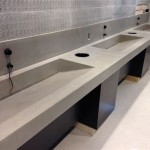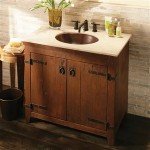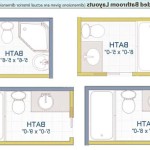How to Replace the Aerator on a Moen Bathroom Faucet
The aerator, a crucial component of a bathroom faucet, plays a vital role in water conservation and overall faucet performance. It mixes air with the water stream, producing a smooth, splash-free flow. Over time, however, mineral deposits and debris can accumulate within the aerator, leading to reduced water pressure, uneven flow, or even complete blockage. Replacing the aerator is a relatively simple and inexpensive task that can significantly improve the functionality and efficiency of a Moen bathroom faucet. This guide provides a comprehensive, step-by-step explanation of the aerator replacement process.
Before commencing the aerator replacement, it is essential to gather the necessary tools and materials. Having everything readily available will streamline the process and minimize potential delays. The required tools and materials typically include:
- New Aerator: Obtain a replacement aerator specifically designed for the Moen faucet model. Consult the faucet's documentation or Moen's website to identify the correct part number. If the specific model number of the faucet is unknown, take the old aerator to a hardware store where a knowledgeable associate can assist in identifying a suitable replacement.
- Aerator Removal Key or Wrench: Many Moen aerators are designed with a unique removal key for easy extraction. The removal key is usually a small, plastic tool with a specific shape that fits into the aerator's slots. If the faucet did not come with a removal key, a small adjustable wrench or needle-nose pliers can be used as a substitute. Exercise caution when using these tools to avoid damaging the faucet's finish.
- Soft Cloth or Towel: A soft cloth or towel is crucial for protecting the faucet's finish from scratches during the removal and installation process. It can also be used to grip the faucet firmly.
- Vinegar or Lime Scale Remover (Optional): If the existing aerator is heavily encrusted with mineral deposits, soaking it in vinegar or a lime scale remover can help loosen the debris, making removal easier.
- Small Container: Place a small container under the faucet to catch any water that may drip out during the aerator replacement.
Identifying the Aerator Type
Moen bathroom faucets employ various aerator designs. Identifying the specific type installed in the faucet is paramount to ensuring compatibility with the replacement aerator and choosing the correct removal method. The most common types include:
Hidden Aerators: These aerators are integrated seamlessly into the faucet spout, making them less visible than traditional aerators. They typically require a specialized removal key to access and remove the aerator assembly. The removal key will have prongs or teeth that match the notches inside the aerator housing.
External Aerators: External aerators are directly visible at the end of the faucet spout. They are usually threaded and can be unscrewed using an adjustable wrench or pliers. Some external aerators also feature a small notch or flat surface for using a specialized removal tool.
Threaded Aerators: Threaded aerators are secured with threads that mate to threads inside the faucet spout. These are typically removed by unscrewing them directly from the faucet.
Push-Fit Aerators: Push-fit aerators are held in place by friction and O-rings. To remove these, you typically need to gently pry them out utilizing the removal key.
Consulting the faucet's documentation or contacting Moen customer support can provide definitive information regarding the aerator type.
Removing the Old Aerator
The aerator removal process varies depending on the type of aerator present. Adhering to the following steps ensures a safe and effective removal:
Turn Off the Water Supply: Before proceeding, turn off the water supply to the faucet. Locate the shut-off valves under the sink and turn them clockwise until they are fully closed. This will prevent water from flowing during the aerator replacement.
Protect the Faucet Finish: Wrap a soft cloth or towel around the faucet spout to protect the finish from scratches or damage during the removal process.
Removing a Hidden Aerator: Insert the aerator removal key into the appropriate slots in the aerator. Gently turn the key counterclockwise until the aerator assembly loosens. Once loosened, carefully pull the aerator assembly out of the faucet spout. If the aerator is stuck, try applying a small amount of penetrating oil to the edges and allowing it to sit for a few minutes before attempting to remove it again. Avoid excessive force that could damage the faucet or the aerator.
Removing an External Aerator: If the aerator has a flat surface for a wrench, use an adjustable wrench to gently loosen the aerator. Turn the wrench counterclockwise. If the aerator does not have a flat surface, use needle-nose pliers. Protect the faucet finish by wrapping it first with a cloth. Grip the aerator with the pliers, and gently turn counterclockwise. Once loosened, unscrew the aerator by hand.
Dealing with Stubborn Aerators: If the aerator is heavily encrusted with mineral deposits, it may be difficult to remove. Soaking the aerator in vinegar or a lime scale remover can help loosen the deposits. Fill a small container with vinegar and submerge the end of the faucet spout containing the aerator. Allow it to soak for at least 30 minutes, or even overnight for severely corroded aerators. After soaking, try removing the aerator again using the appropriate tool.
Inspecting the Faucet Spout: Once the aerator is removed, inspect the inside of the faucet spout for any remaining debris or mineral deposits. Use a small brush or cloth to clean the threads and ensure a smooth surface for the new aerator. Make sure to rinse the spout thoroughly to remove any cleaning solution residue.
Installing the New Aerator
After successfully removing the old aerator and cleaning the faucet spout, the new aerator can be installed. This process is generally straightforward, but attention to detail is crucial to ensure a secure and leak-free installation.
Checking the Components: Before installing the new aerator, carefully examine its components. Most aerator assemblies include the aerator body, a rubber washer or O-ring, and a screen or flow restrictor. Make sure all components are present and in good condition. Replace any damaged or missing parts before proceeding.
Installing a Hidden Aerator: Align the new aerator assembly with the faucet spout. Gently push the aerator assembly into the spout until it is fully seated. Insert the aerator removal key into the designated slots and turn it clockwise to tighten the aerator assembly. Avoid over-tightening, as this could damage the aerator or the faucet. The aerator should be snug but not excessively tight.
Installing an External Aerator: Align the threads of the new aerator with the threads inside the faucet spout. Gently screw the aerator into the spout by hand. Once the aerator is snug, use an adjustable wrench to tighten it slightly further. Again, avoid over-tightening. The aerator should be firmly in place but not so tight that it is difficult to remove in the future.
Testing for Leaks: After installing the new aerator, turn the water supply back on slowly. Carefully inspect the aerator and the faucet spout for any leaks. If leaks are present, tighten the aerator slightly further. If the leaks persist, remove the aerator and check the O-ring or washer for damage or misplacement. Replace the O-ring or washer if necessary and reinstall the aerator.
Adjusting the Water Flow: Once the new aerator is installed and there are no leaks, test the water flow. The new aerator should provide a smooth, splash-free flow with adequate water pressure. If the water flow is too low, consult the aerator's instructions for possible adjustments. Some aerators allow for adjusting the flow rate by turning a small screw or removing a flow restrictor.
Regularly inspect and clean the aerator to prolong its lifespan. Depending on water quality, cleaning may be necessary every few months. If cleaning doesn’t return the aerator to adequate performance, replacement will be necessary.

Moen Eva 6410 Faucet Aerator Upgrade Replacement Repair 137401

How To Install A Water Saving Aerator In Your Moen Bathroom Faucet

Remove Aerator From Moen Faucet Non Threaded
How To Remove An Aerator From A Moen Faucet Quora

How To Reassemble Your Faucet S Aerator The Lone Sysadmin

Remove Aerator From Moen Faucet Non Threaded

How To Remove An Aerator From A Moen Kitchen Faucet Mr Faucets

Moen Faucet Aerator Key Flat Head Driver Remove Low Flow Filter Kitchens Diy

Moen Faucet Aerator Key Flat Head Driver Remove Low Flow Filter Kitchens Diy

Fixing A Faucet Aerator You Can Be Diy R Too The Kim Six Fix
Related Posts






